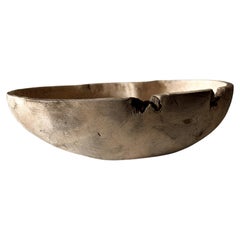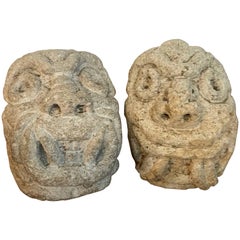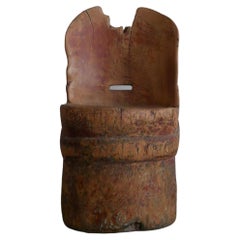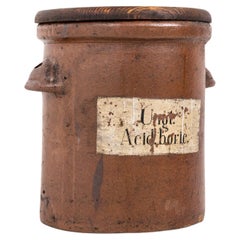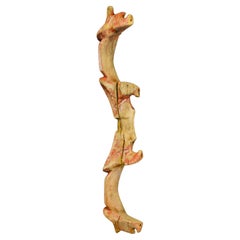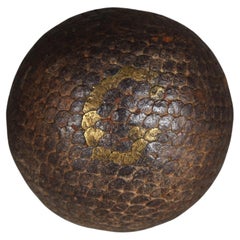Carved Antiquities
1
137
to
10
70
60
137
137
137
22
17
11
1
1
1
1
32
64
41
18
11
4
3
1
3
1
1
1
119
26
25
18
8
84
27
20
20
17
11
7
Technique: Carved
Antique Wabi Sabi Wooden Root Bowl, Scandinavia c. 1800s
Located in Hønefoss, 30
A wonderfil antique wabi sabi wooden root bowl with beautiful patina from age and use.
Category
Mid-19th Century Norwegian Romantic Antique Carved Antiquities
Materials
Wood
Two Carved Mayan Deity Limestone Architectural Carvings or Elements
Located in West Palm Beach, FL
Two carved Mayan deity limestone architectural carvings or / elements, 19th century or older
The larger measures 7" W x 5.5" H x 4.5" D with a 2.5" protrusion
The smaller measures ...
Category
19th Century Central American Pre-Columbian Antique Carved Antiquities
Materials
Limestone
Norwegian Stump Chair ca 1820s
Located in Farsta, SE
Norwegian Stump Chair late 1800-century
Made out of pine with amazing patina and some original paint left.
Height: 70 cm/27.5 inc
Depth: 25 cm/9.8 inch
Width: 37 cm/14.5 inch
Seat ...
Category
Early 19th Century Swedish Folk Art Antique Carved Antiquities
Materials
Pine
Antique Salt Glazed Clay Apothocary Chemist Hand Painted Jar Tub Pot. c.1900
Located in London, GB
An original salt glazed clay apothecary jar. c.1900
Once containing boric acid and likely used is a pharmacy. Perfect for repurposing as a plant pot or log bin. Remnants of the hand...
Category
Mid-20th Century English Edwardian Carved Antiquities
Materials
Wood
A Carved Alpine Oxen Yoke - French Alps - XIXth century.
Located in SOTTEVILLE-LÈS-ROUEN, FR
A huge carved oxen yoke, dating back to the 19th century, is a beautiful example of Alpine folk craftsmanship. Its intricate carvings and rustic charm make it a truly captivating dec...
Category
Late 19th Century French French Provincial Antique Carved Antiquities
Materials
Wood
Antique Boule Ball "G", Pétanque, 1880s, France, Craftsmanship
Located in Greven, DE
Beautiful, unique Boule ball, France, late 19th Century.
In the 19th century, the manufacture of boules balls underwent significant development in France as the game of boules, particularly the pétanque variant, gained in popularity. The manufacture of boules balls during this period was a manual process that required expertise, precision and love to detail.
In the late 19th and early 20th centuries, particularly in rural areas of France and other Mediterranean regions, olive wood was a commonly used source of material for making boules balls. This was not only due to the availability of the material, but also to the outstanding properties of olive wood, which was characterized by hardness, strength and a rich grain.
First, the olive wood was carefully selected and shaped into raw balls, which were then sanded to the desired size and shape. The nails were then hammered into the balls one by one, making sure that they were evenly distributed and firmly anchored. Finally, the spheres were polished and coated with a protective varnish to enhance their natural beauty and protect them from the elements.
The use of nails to decorate and reinforce olive wood boules was a traditional practice that not only gave the ball a rustic aesthetic, but also improved its durability and contributed to customization. Many balls were made according to the specific requirements and preferences of the players. Nails were driven at regular intervals around the ball, with each nail hole precisely placed so as not to affect the balance and weight distribution of the ball. These nails not only served as a decorative element, but also helped to strengthen the structure of the ball and make it more resistant to the hard knocks and wear and tear during play. Individual engravings or decorations were often applied to the balls to make them unique and identify the player.
Antique boules...
Category
Late 19th Century French Late Victorian Antique Carved Antiquities
Materials
Metal
Antique Boule Ball "G", Pétanque, 1880s, France, Craftsmanship
Located in Greven, DE
Beautiful, unique Boule ball, France, late 19th Century.
In the 19th century, the manufacture of boules balls underwent significant development in France as the game of boules, particularly the pétanque variant, gained in popularity. The manufacture of boules balls during this period was a manual process that required expertise, precision and love to detail.
In the late 19th and early 20th centuries, particularly in rural areas of France and other Mediterranean regions, olive wood was a commonly used source of material for making boules balls. This was not only due to the availability of the material, but also to the outstanding properties of olive wood, which was characterized by hardness, strength and a rich grain.
First, the olive wood was carefully selected and shaped into raw balls, which were then sanded to the desired size and shape. The nails were then hammered into the balls one by one, making sure that they were evenly distributed and firmly anchored. Finally, the spheres were polished and coated with a protective varnish to enhance their natural beauty and protect them from the elements.
The use of nails to decorate and reinforce olive wood boules was a traditional practice that not only gave the ball a rustic aesthetic, but also improved its durability and contributed to customization. Many balls were made according to the specific requirements and preferences of the players. Nails were driven at regular intervals around the ball, with each nail hole precisely placed so as not to affect the balance and weight distribution of the ball. These nails not only served as a decorative element, but also helped to strengthen the structure of the ball and make it more resistant to the hard knocks and wear and tear during play. Individual engravings or decorations were often applied to the balls to make them unique and identify the player.
Antique boules...
Category
Late 19th Century French Late Victorian Antique Carved Antiquities
Materials
Metal
Antique Boule Ball "7", Pétanque, 1880s, France, Craftsmanship
Located in Greven, DE
Beautiful, unique Boule ball, France, late 19th Century.
In the 19th century, the manufacture of boules balls underwent significant development in France as the game of boules, particularly the pétanque variant, gained in popularity. The manufacture of boules balls during this period was a manual process that required expertise, precision and love to detail.
In the late 19th and early 20th centuries, particularly in rural areas of France and other Mediterranean regions, olive wood was a commonly used source of material for making boules balls. This was not only due to the availability of the material, but also to the outstanding properties of olive wood, which was characterized by hardness, strength and a rich grain.
First, the olive wood was carefully selected and shaped into raw balls, which were then sanded to the desired size and shape. The nails were then hammered into the balls one by one, making sure that they were evenly distributed and firmly anchored. Finally, the spheres were polished and coated with a protective varnish to enhance their natural beauty and protect them from the elements.
The use of nails to decorate and reinforce olive wood boules was a traditional practice that not only gave the ball a rustic aesthetic, but also improved its durability and contributed to customization. Many balls were made according to the specific requirements and preferences of the players. Nails were driven at regular intervals around the ball, with each nail hole precisely placed so as not to affect the balance and weight distribution of the ball. These nails not only served as a decorative element, but also helped to strengthen the structure of the ball and make it more resistant to the hard knocks and wear and tear during play. Individual engravings or decorations were often applied to the balls to make them unique and identify the player.
Antique boules...
Category
Late 19th Century French Late Victorian Antique Carved Antiquities
Materials
Metal
Late-Period to Ptolemaic Period Egyptian Wooden Mummy Mask Ear on Custom Mount
Located in Chicago, IL
This Late Period to Ptolemaic Period Egyptian carved wood ear, once part of a mummy mask, stands as a poignant testament to ancient Egyptian customs and beliefs. Dating back over 250...
Category
15th Century and Earlier Egyptian Egyptian Antique Carved Antiquities
Materials
Wood
Pair Inuit Seal and Whale Scrimshaw Walrus Ivory Tusks
Located in Dallas, TX
A pair of antique Alaskan walrus tusks with scrimshaw decoration, one with three different whales the other with three different seals.
Alaska, United States
Length: 29.5 Inches.
...
Category
Early 1900s American Tribal Antique Carved Antiquities
Materials
Bone
Antique Boule Set, Boule Balls, Pétanque, 1880s, France, Craftsmanship
Located in Greven, DE
Beautiful, unique Boule set of two Boule balls and one target ball, France, late 19th century.
In the 19th century, the manufacture of boule balls underwent significant development ...
Category
Late 19th Century French Late Victorian Antique Carved Antiquities
Materials
Olive
Pair Of Antique Boule Balls, Pétanque, 1880s, France, Craftsmanship
Located in Greven, DE
Beautiful, unique Boule ball pair and one target ball, France, late 19th Century.
In the 19th century, the manufacture of boules balls underwent significant development in France as...
Category
Late 19th Century French Late Victorian Antique Carved Antiquities
Materials
Metal
Arma Christi Calvary, France 19th Century
Located in PARIS, FR
Superb and rare Arma Christi calvary, popular work, France end of the 19th century. Beautifully executed work.
Fair condition. Several small misses and ancient restaurations. Seen ...
Category
19th Century French Folk Art Antique Carved Antiquities
Materials
Wood
Pair Of Antique Boule Balls, Pétanque, 1880s, France, Craftsmanship
Located in Greven, DE
Beautiful, unique Boule ball pair, France, late 19th Century.
Diameter 9,5 cm.
In the 19th century, the manufacture of boules balls underwent significant development in France as the game of boules, particularly the pétanque variant, gained in popularity. The manufacture of boules balls during this period was a manual process that required expertise, precision and love to detail.
In the late 19th and early 20th centuries, particularly in rural areas of France and other Mediterranean regions, olive wood was a commonly used source of material for making boules balls. This was not only due to the availability of the material, but also to the outstanding properties of olive wood, which was characterized by hardness, strength and a rich grain.
First, the olive wood was carefully selected and shaped into raw balls, which were then sanded to the desired size and shape. The nails were then hammered into the balls one by one, making sure that they were evenly distributed and firmly anchored. Finally, the spheres were polished and coated with a protective varnish to enhance their natural beauty and protect them from the elements.
The use of nails to decorate and reinforce olive wood boules was a traditional practice that not only gave the ball a rustic aesthetic, but also improved its durability and contributed to customization. Many balls were made according to the specific requirements and preferences of the players. Nails were driven at regular intervals around the ball, with each nail hole precisely placed so as not to affect the balance and weight distribution of the ball. These nails not only served as a decorative element, but also helped to strengthen the structure of the ball and make it more resistant to the hard knocks and wear and tear during play. Individual engravings or decorations were often applied to the balls to make them unique and identify the player.
Antique boules...
Category
Late 19th Century French Late Victorian Antique Carved Antiquities
Materials
Olive
Pair Of Antique Boule Balls "3", Pétanque, 1880s, France, Craftsmanship
Located in Greven, DE
Beautiful, unique Boule ball pair and one target ball, France, late 19th Century.
Decorated with the numer "3" on each of the Boule balls.
In the 19th century, the manufacture of b...
Category
Late 19th Century French Late Victorian Antique Carved Antiquities
Materials
Olive
Antique Boule Set, Boule Balls, Pétanque, 1880s, France, Craftsmanship
Located in Greven, DE
Beautiful, unique Boule set of three Boule balls and one target ball, France, late 19th Century.
Diameter 8,5 cm.
Fantastic colour and patina!
In the 19th century, antique metal boules balls experienced a renaissance that took the game of boules to a new level.
These ornately crafted balls were not only instruments of the game, but also symbols of elegance and sophistication in leisure activities.
Made from high-quality metals such as steel or brass, Boule balls were forged and polished by skilled craftsmen to ensure a smooth and even surface.
The antique boules...
Category
Late 19th Century French Late Victorian Antique Carved Antiquities
Materials
Metal
Pair Of Antique Boule Balls "3", "V", Pétanque, 1880s, France, Craftsmanship
Located in Greven, DE
Beautiful, unique Boule ball pair, France, late 19th Century.
Decorated with the numer "3" on each ball and with a "V" on one of the Boule balls.
In the 19th century, the manufactur...
Category
Late 19th Century French Late Victorian Antique Carved Antiquities
Materials
Olive
Pair Of Antique Boule Balls "24", Pétanque, 1880s, France, Craftsmanship
Located in Greven, DE
Beautiful, unique Boule ball pair and one target ball, France, late 19th Century.
In the 19th century, the manufacture of boules balls underwent significant development in France as...
Category
Late 19th Century French Late Victorian Antique Carved Antiquities
Materials
Olive
Pair Of Antique Boule Balls Circle, Pétanque, 1880s, France, Craftsmanship
Located in Greven, DE
Beautiful, unique Boule ball pair and one target ball, France, late 19th Century.
In the 19th century, the manufacture of boules balls underwent significant development in France as...
Category
Late 19th Century French Late Victorian Antique Carved Antiquities
Materials
Olive
Antique Boule Balls Set "9", Pétanque, 1880s, France, Craftsmanship
Located in Greven, DE
Beautiful, unique Boule set of three Boule balls and one target ball, France, late 19th century.
In the 19th century, the manufacture of boules balls underwent significant development in France as the game of boules, particularly the pétanque variant, gained in popularity. The manufacture of boules balls during this period was a manual process that required expertise, precision and love to detail.
In the late 19th and early 20th centuries, particularly in rural areas of France and other Mediterranean regions, olive wood was a commonly used source of material for making boules balls. This was not only due to the availability of the material, but also to the outstanding properties of olive wood, which was characterized by hardness, strength and a rich grain.
First, the olive wood was carefully selected and shaped into raw balls, which were then sanded to the desired size and shape. The nails were then hammered into the balls one by one, making sure that they were evenly distributed and firmly anchored. Finally, the spheres were polished and coated with a protective varnish to enhance their natural beauty and protect them from the elements.
The use of nails to decorate and reinforce olive wood boules was a traditional practice that not only gave the ball a rustic aesthetic, but also improved its durability and contributed to customization. Many balls were made according to the specific requirements and preferences of the players. Nails were driven at regular intervals around the ball, with each nail hole precisely placed so as not to affect the balance and weight distribution of the ball. These nails not only served as a decorative element, but also helped to strengthen the structure of the ball and make it more resistant to the hard knocks and wear and tear during play. Individual engravings or decorations were often applied to the balls to make them unique and identify the player.
Antique boules...
Category
Late 19th Century French Late Victorian Antique Carved Antiquities
Materials
Olive
Antique Boule Ball "G", "J", Pétanque, 1880s, France, Craftsmanship
Located in Greven, DE
Beautiful, unique Boule ball, France, late 19th Century.
Decorated with the initials "G" and "J".
In the 19th century, the manufacture of boules balls underwent significant developm...
Category
Late 19th Century French Late Victorian Antique Carved Antiquities
Materials
Olive
Antique Boule Balls Set "B", Pétanque, 1880s, France, Craftsmanship
Located in Greven, DE
Beautiful, unique Boule set of three Boule balls and one target ball, France, late 19th century.
In the 19th century, the manufacture of boules balls underwent significant development in France as the game of boules, particularly the pétanque variant, gained in popularity. The manufacture of boules balls during this period was a manual process that required expertise, precision and love to detail.
In the late 19th and early 20th centuries, particularly in rural areas of France and other Mediterranean regions, olive wood was a commonly used source of material for making boules balls. This was not only due to the availability of the material, but also to the outstanding properties of olive wood, which was characterized by hardness, strength and a rich grain.
First, the olive wood was carefully selected and shaped into raw balls, which were then sanded to the desired size and shape. The nails were then hammered into the balls one by one, making sure that they were evenly distributed and firmly anchored. Finally, the spheres were polished and coated with a protective varnish to enhance their natural beauty and protect them from the elements.
The use of nails to decorate and reinforce olive wood boules was a traditional practice that not only gave the ball a rustic aesthetic, but also improved its durability and contributed to customization. Many balls were made according to the specific requirements and preferences of the players. Nails were driven at regular intervals around the ball, with each nail hole precisely placed so as not to affect the balance and weight distribution of the ball. These nails not only served as a decorative element, but also helped to strengthen the structure of the ball and make it more resistant to the hard knocks and wear and tear during play. Individual engravings or decorations were often applied to the balls to make them unique and identify the player.
Antique boules...
Category
Late 19th Century French Late Victorian Antique Carved Antiquities
Materials
Olive
Pair Of Antique Boule Balls "G", Pétanque, 1880s, France, Craftsmanship
Located in Greven, DE
Beautiful, unique Boule ball pair, France, late 19th Century.
In the 19th century, the manufacture of boules balls underwent significant development in France as the game of boules,...
Category
Late 19th Century French Late Victorian Antique Carved Antiquities
Materials
Olive
Pair Of Antique Boule Balls "4", Pétanque, 1880s, France, Craftsmanship
Located in Greven, DE
Beautiful, unique Boule ball pair, France, late 19th Century.
Diameter 9,4 cm.
In the 19th century, the manufacture of boules balls underwent significant development in France as th...
Category
Late 19th Century French Late Victorian Antique Carved Antiquities
Materials
Olive
Antique Boule Balls Set "B", Pétanque, 1880s, France, Craftsmanship
Located in Greven, DE
Beautiful, unique Boule set of three Boule balls, France, late 19th Century.
In the 19th century, the manufacture of boules balls underwent significant development in France as the game of boules, particularly the pétanque variant, gained in popularity. The manufacture of boules balls during this period was a manual process that required expertise, precision and love to detail.
In the late 19th and early 20th centuries, particularly in rural areas of France and other Mediterranean regions, olive wood was a commonly used source of material for making boules balls. This was not only due to the availability of the material, but also to the outstanding properties of olive wood, which was characterized by hardness, strength and a rich grain.
First, the olive wood was carefully selected and shaped into raw balls, which were then sanded to the desired size and shape. The nails were then hammered into the balls one by one, making sure that they were evenly distributed and firmly anchored. Finally, the spheres were polished and coated with a protective varnish to enhance their natural beauty and protect them from the elements.
The use of nails to decorate and reinforce olive wood boules was a traditional practice that not only gave the ball a rustic aesthetic, but also improved its durability and contributed to customization. Many balls were made according to the specific requirements and preferences of the players. Nails were driven at regular intervals around the ball, with each nail hole precisely placed so as not to affect the balance and weight distribution of the ball. These nails not only served as a decorative element, but also helped to strengthen the structure of the ball and make it more resistant to the hard knocks and wear and tear during play. Individual engravings or decorations were often applied to the balls to make them unique and identify the player.
Antique boules...
Category
Late 19th Century French Late Victorian Antique Carved Antiquities
Materials
Olive
Japanese Lacquered Wood Bowls 19th Century Asian Antiques 中国古董
Located in London, GB
Fine Pair Japanese Lacquered Wood Bowls 19th Century Meiji
Beautiful and elegant example of Japanese lacquer ware with and gold gilt, Rice bowls ...
Category
19th Century Japanese Antique Carved Antiquities
Materials
Wood, Lacquer
Antique Boule Set, Boule Balls, Pétanque, 1880s, France, Craftsmanship
Located in Greven, DE
Beautiful, unique Boule set of three Boule balls, France, late 19th century.
In the 19th century, antique metal boules balls experienced a renaissance that took the game of boules to a new level.
These ornately crafted balls were not only instruments of the game, but also symbols of elegance and sophistication in leisure activities.
Made from high-quality metals such as steel or brass, Boule balls were forged and polished by skilled craftsmen to ensure a smooth and even surface.
The antique boules...
Category
Late 19th Century French Late Victorian Antique Carved Antiquities
Materials
Metal
Antique Boule Set, Boule Balls, Pétanque, 1880s, France, Craftsmanship
Located in Greven, DE
Beautiful, unique Boule set of three Boule balls and one target ball, France, late 19th century.
In the 19th century, the manufacture of boule balls underwent significant developmen...
Category
Late 19th Century French Late Victorian Antique Carved Antiquities
Materials
Olive
Antique Boule Set, Boule Balls, Pétanque, 1880s, France, Craftsmanship
Located in Greven, DE
Beautiful, unique Boule set of three Boule balls and one target ball, France, late 19th Century.
Fantastic colour and patina!
In the 19th century, antique metal boules balls experienced a renaissance that took the game of boules to a new level.
These ornately crafted balls were not only instruments of the game, but also symbols of elegance and sophistication in leisure activities.
Made from high-quality metals such as steel or brass, Boule balls were forged and polished by skilled craftsmen to ensure a smooth and even surface.
The antique boules...
Category
Late 19th Century French Late Victorian Antique Carved Antiquities
Materials
Metal
Antique Boule Set, Boule Balls, Pétanque, 1880s, France, Craftsmanship
Located in Greven, DE
Beautiful, unique Boule set of three Boule balls and one target ball, France, late 19th century.
In the 19th century, the manufacture of boules balls underwent significant developme...
Category
Late 19th Century French Late Victorian Antique Carved Antiquities
Materials
Olive
Vintage Mid-Century Wooden Csrved Male Head Gentleman Bust Art
Located in London, GB
A wonderfully carved wooden head of a male.
Age unknown, but super decorative and skillfully carved from a single piece of heart wood. Heavy and solid and in as found condition. S...
Category
Mid-20th Century English Mid-Century Modern Carved Antiquities
Materials
Wood
Fine and Rare Early 19th Century Carved Bootjack in the Form of a Pistol
Located in Oxfordshire, United Kingdom
A fine and rare !9th Century hand carved antique treen bootjack, to remove riding boots, in the unusual form of a pistol.
This is a rare find and unfolds to form a bootjack with be...
Category
19th Century Antique Carved Antiquities
Materials
Beech
Russian Carved Coachman 18-Karat Gold Enamel Lapis Figure Manner of Fabergé
By Modern Fabergé, Peter Carl Fabergé
Located in San Diego, CA
Exquisite hand carved Russian hard stone "Coachman" sculpture figure dating from the early 1900s. In the manner of Fabergé. Made of solid lapis lazuli. Beard is made of gray obsidian...
Category
Early 20th Century Russian Carved Antiquities
Materials
Lapis Lazuli
Skeleton Boat Hull Model circa 1840
Located in Arundel, GB
Ref: JC5205
19th century skeleton boat hull
Scotland circa 1840
Measurements: H: 25.5cm (10") W: 32cm (12.6") D: 75cm (29.5")
Category
1840s Scottish Antique Carved Antiquities
Materials
Pine
circa 1910 Folk Art Whirligig
Located in Arundel, GB
Two folk art whirligigs: Army Offiers; one with a kilt and sporran.
England circa 1910
Measurements: H: 40cm (15.7") W: 10.5cm (4.1") D: 6.5cm (2.6")
Category
1910s English Vintage Carved Antiquities
Materials
Pine
Ancient Egyptian Polychromed Ushabti New Kingdom, Ramesside Dynasty 1292-1185 BC
Located in Nottingham, GB
Ancient Egyptian wooden Ushabti with funerary coffin, carved polychromed wood, New Kingdom, Ramesside Period, 1292-1185 BC. Shabti measuring 18cm
For a similar example see: the shabti coffin of Sennedjem in the Pushkin State Museum for Art, accession no. I.1.a 1662
Wear and flaking to paint throughout. Some small chips. Some natural wood splits. Please refer to images.
An Egyptian ushabti...
Category
15th Century and Earlier Antique Carved Antiquities
Materials
Wood
Antique Danish Mangle Board Wedding Love Gift Painted Wood, Horse Handle, 1803
Located in Aarhus C, DK
Antique Danish mangle board (clothing and bedding press) dated 1803.
It is made from oak wood which is hand carved with a rich decoration of geometric blossoms. Painted in the colou...
Category
Early 19th Century Scandinavian Folk Art Antique Carved Antiquities
Materials
Wood
Antique Bread Board
Located in Arundel, GB
Ref: 125320
Carved wooden bread board - Welcome
England circa 1900
Measurements: W: 32cm (12.6")
Excluding Delivery. Please enquire providing a postcode for a delivery quote.
Category
Early 19th Century British Antique Carved Antiquities
Materials
Sycamore
H67cm Swedish Horse, handmade folk craft circa 1800, highly decorative element
Located in Forest, BE
Big Swedish horse from the early 19th century. Made of pine wood with the famous red paint. It is worn but in a very nice way. The patina shows the trace of time. There's a whole on ...
Category
Early 19th Century Swedish Folk Art Antique Carved Antiquities
Materials
Pine
Antique Black Forest Serving Plate With Music Box, Hand-Carved Folk Art
Located in Greven, DE
This beautiful hand-carved Black Forest serving plate hides a music box in its base. An extraordinary piece of folk art from the mid-20th century.
The music box can be operated with ...
Category
20th Century Unknown Carved Antiquities
Materials
Wood
Historic Rare Carved memorial plaque made by Jewish internee in Cyprus, 1948
Located in Tel Aviv - Jaffa, IL
super rare and historic example of Cyprus stone carving, made by jewish holocaust surviver that was Detained at the Internment camps in Cyprus, just 3 years after the holocaust. this piece is very unusual, most of this carvings shows us aspects of living in the Refugee camps or zionist views of israel, sometimes they even made judaica objects like menorahs Or Candlesticks, but its rare to find memorial plaques such as the example in front of us, the plaques was Damaged In the way to israel and two pieces from the upper section were broken off, the middle part of the Plaque shows a Scroll shaped memorial plaque with the inscription : "for the dead who died on the name of god" In red color, the middle has a yellow star carved and painted, just like the yellow star jewish...
Category
1940s Cypriot Vintage Carved Antiquities
Materials
Soapstone
Sycamore chessel mould curd drainer
Located in Arundel, GB
Ref: 122623
Sycamore chessel mould curd drainer
England circa 1760
Measurements: H: 9cm (3.5") W: 20cm (7.9")
Excluding Delivery. Please enquire providing a postcode for a del...
Category
18th Century British Antique Carved Antiquities
Materials
Sycamore
Naive 19th Century Caryatid
Located in Arundel, GB
Ref: 125885
Naive Caryatid with linen fold detail.
England, circa 1840.
Measurements: H: 48cm (18.9") W: 9cm (3.5") D: 7.5cm (3")
Excluding Delivery. Please enquire providing a ...
Category
Mid-19th Century British Antique Carved Antiquities
Materials
Pine
Late 17th century hand-carved wooden head
Located in Oostende, BE
Late 17th - early 18th century hand-carved wooden head from Southern Europe. Made from poplar wood. Wear consistent with age and use.
Category
Late 17th Century Italian Antique Carved Antiquities
Materials
Poplar
Pair of 18th Century Italian Rococo Gold Leaf Tassel Ornaments
By Interi
Located in Dublin, Dalkey
Pair of 18th century Italian hand-carved gold leaf tassel ornaments.
They are two of the same shape of tassel but in two different sizes ...
Category
18th Century Italian Rococo Antique Carved Antiquities
Materials
Gold Leaf, Metal
Japanese Antique Wooden Board, "Abstract Sculptures", Wabi-Sabi, Mingei
Located in Katori-Shi, 12
This is a wooden antique board from the Meiji era.
It is made of Japanese cedar wood.
It has a beautiful appearance due to years of use and aging.
It was used as a board for kneadi...
Category
Early 20th Century Meiji Carved Antiquities
Materials
Wood
Japanese Antique Wooden Board, "Abstract Sculptures", Wabi-Sabi, Mingei
Located in Katori-Shi, 12
This is a wooden antique board from the Meiji era.
It is made of Japanese cedar wood.
It has a beautiful appearance due to years of use and aging.
It was used as a board for kneadi...
Category
Early 20th Century Meiji Carved Antiquities
Materials
Wood
Life Size Swan Decoy
Located in Coeur d'Alene, ID
Swan decoy from Havre de Grace, Maryland. Original paint.
Period: Mid-20th century
Origin: Maine, United States
Size: 32” x 10” x 17’
Family Owned & Operated
Cisco’s Gallery deals ...
Category
Mid-20th Century American Carved Antiquities
Materials
Wood
Chinese Lotus Mooncake Mold, c. 1900
Located in Chicago, IL
This 19th-century hand-held wood press is carved with a large mold used for shaping festive mooncakes. Packed with lotus root, red bean, or other regional fillings, mooncakes are a d...
Category
Early 20th Century Chinese Qing Carved Antiquities
Materials
Wood
Antique Danish Mangle Board Wedding Love Gift Painted Wood with Horse Handle
Located in Aarhus C, DK
Antique Danish mangle board (clothing and bedding press) from ca. 1800 to 1850.
It is made from oak wood which is hand carved with a rich decoration with geometric blossoms and lots...
Category
Early 19th Century Scandinavian Folk Art Antique Carved Antiquities
Materials
Wood
Mughal Indian Betel Nut Cutter, Mid 19th Century
Located in Islamabad, PK
A 19th-century Mughal brass betel nut cutter, also known as a "sarota" in the Indian subcontinent, is a fine example of the exquisite craftsmanship an...
Category
19th Century Anglo-Indian Antique Carved Antiquities
Materials
Brass, Steel
Life Size Swan Decoy by Jim Pierce
Located in Coeur d'Alene, ID
Swan decoy carved in the style of Madison Mitchell by Jim Pierce. Haver D. Grace, Maryland. Signed and dated 1981. Made from a cedar pole from Aberdee...
Category
Late 20th Century American Carved Antiquities
Materials
Wood
Handheld Chinese Mooncake Mold with Lotus Pods, c. 1900
Located in Chicago, IL
This late 19th century hand-held wood press is carved with a large mold used for shaping festive mooncakes. Packed with lotus root, red bean, or other regional fillings, mooncakes ar...
Category
Early 20th Century Chinese Qing Carved Antiquities
Materials
Wood
Handheld Chinese Mooncake Mold, c. 1900
Located in Chicago, IL
This late 19th century hand-held wood press is carved with a large mold used for shaping festive mooncakes. Packed with lotus root, red bean, or other regional fillings, mooncakes ar...
Category
Early 20th Century Chinese Qing Carved Antiquities
Materials
Wood
Life Size Swan Decoy
Located in Coeur d'Alene, ID
Decorative swan decoy carved from a barn beam. Glass eyes, original paint. Carver unknown. Original cream white paint.
Period: Mid-20th century
Origin: United States
Size: 25" x 10"...
Category
Mid-20th Century American Carved Antiquities
Materials
Wood
Handheld Chinese Mooncake Mold, c. 1900
Located in Chicago, IL
This late 19th century hand-held wood press is carved with a large mold used for shaping festive mooncakes. Packed with lotus root, red bean, or other regional fillings, mooncakes ar...
Category
Early 20th Century Chinese Qing Carved Antiquities
Materials
Wood
20th Century Crow Decoy
Located in Coeur d'Alene, ID
Early 20th Century carved and painted crow decoy with glass eyes and wire legs.
Period: Early 20th century
Origin: United States
Size: 10"L x 8"H x 4"W
Family Owned & Operated
Cisc...
Category
20th Century American Carved Antiquities
Materials
Wood
Handheld Chinese Mooncake Mold with Lotus Pods, c. 1900
Located in Chicago, IL
This late 19th century hand-held wood press is carved with a large mold used for shaping festive mooncakes. Packed with lotus root, red bean, or other regional fillings, mooncakes ar...
Category
Early 20th Century Chinese Qing Carved Antiquities
Materials
Wood
Recently Viewed
View AllMore Ways To Browse
3 Door Display Case
Antique China Display Case
Antique Chinese Display Case
Antique Walnut Glass Display Case
Blue Painted Chest Of Drawers
Book Slide
Cabinet Pulls And Knobs
Italian Door Surround
Jewellery Display Case
Jewelry Display Case
Jewelry Display Cases
Jewlery Display Case
Kitchen Storage Racks
Maple Dresser Vintage
Marble Top Bombe Chest
Mid Century Console Credenza
Painted Wooden Chest
Painted Wooden Chests
